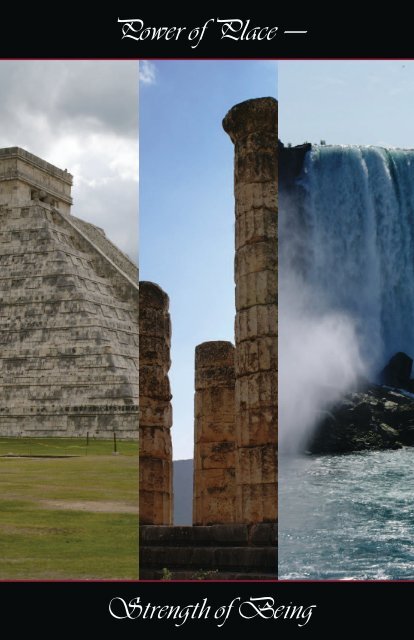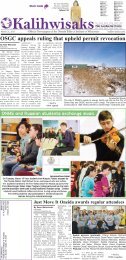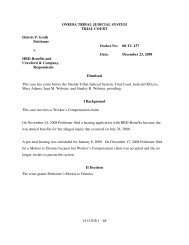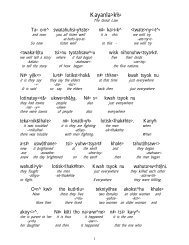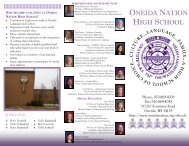Power of Place — Strength of Being - The Oneida Nation of Wisconsin
Power of Place — Strength of Being - The Oneida Nation of Wisconsin
Power of Place — Strength of Being - The Oneida Nation of Wisconsin
Create successful ePaper yourself
Turn your PDF publications into a flip-book with our unique Google optimized e-Paper software.
<strong>Power</strong> <strong>of</strong> <strong>Place</strong> <strong>—</strong><br />
<strong>Strength</strong> <strong>of</strong> <strong>Being</strong>
We Gratefully Acknowledge the Support Of<br />
<strong>The</strong> Ontario Arts Council,<br />
the Sovereign <strong>Oneida</strong> <strong>Nation</strong> <strong>of</strong> <strong>Wisconsin</strong>,<br />
and the <strong>Oneida</strong> <strong>Nation</strong> Arts Program<br />
<strong>Power</strong> <strong>of</strong> <strong>Place</strong> <strong>—</strong> <strong>Strength</strong> <strong>of</strong> <strong>Being</strong><br />
Kuba Cloth, East Africa, 1940-Present – Raffia and Natural Pigments
<strong>Power</strong> <strong>of</strong> <strong>Place</strong> –<br />
<strong>Strength</strong> <strong>of</strong> <strong>Being</strong><br />
5 <strong>Power</strong> <strong>of</strong> <strong>Place</strong><strong>—</strong><strong>Strength</strong> <strong>of</strong> <strong>Being</strong><br />
Samuel Thomas<br />
9 <strong>The</strong> Magic <strong>of</strong> Beads<strong>—</strong><strong>The</strong> Beadwork <strong>of</strong> Sam Thomas<br />
Shelly Niro<br />
13 <strong>Power</strong>ful Art for <strong>Power</strong>ful <strong>Place</strong>s<br />
Trudy Nicks, PhD<br />
17 Cayuga Cosmopolitanism: <strong>The</strong> Beaded Art <strong>of</strong> Sam Thomas<br />
Ruth B. Phillips, PhD<br />
21 A World <strong>of</strong> Materials: <strong>The</strong> Beadwork Art <strong>of</strong> Sam Thomas<br />
Richard Green<br />
25 Kasatste: Through <strong>The</strong> Eye <strong>of</strong> a Needle<br />
Susan M. Hill, PhD<br />
01
02<br />
Foreword:<br />
Amazing. That is what people feel when they see Samuel Thomas’s<br />
beadwork and especially amazing are the pieces <strong>of</strong> beadwork created<br />
in his latest project <strong>Power</strong> <strong>of</strong> <strong>Place</strong> – <strong>Strength</strong> <strong>of</strong> <strong>Being</strong>. <strong>The</strong> authors <strong>of</strong><br />
the essays in this publication clearly agree as you will see when you read<br />
what they have written about Sam and his ambitious project. In addition,<br />
the essay writers, internationally recognized artists, pr<strong>of</strong>essors, and<br />
museum pr<strong>of</strong>essionals, are pretty amazing people themselves. All<br />
are experts on Haudenosaunee art including beadwork, many have<br />
published on various aspects <strong>of</strong> this increasingly appreciated art form.<br />
Most have followed Sam’s career for twenty-five years or more. <strong>The</strong>y<br />
not only see Sam’s artwork as amazing, they see his career from a selftaught<br />
teenager from the Six <strong>Nation</strong>s <strong>of</strong> the Grand River Reserve to a<br />
world traveler as amazing also.<br />
Sam visited six places <strong>of</strong> power, created six pieces <strong>of</strong> beadwork inspired<br />
by those six places, and includes six essays in this publication. Each<br />
essay describes the writer’s impressions <strong>of</strong> the beadwork that Sam<br />
created during his journeys to powerful places in Africa, Europe, and<br />
the Americas.<br />
Shelley Niro, who like Sam, calls the Six <strong>Nation</strong>s <strong>of</strong> the Grand River<br />
Reserve home, is a talented Mohawk artist who recognizes the art form<br />
and both the historical and contemporary aspects <strong>of</strong> his work. Dr. Trudy<br />
Nicks, Senior Curator for the Royal Ontario Museum’s Department <strong>of</strong><br />
World Cultures, points out the common experiences <strong>of</strong> indigenous<br />
people, including the Haudenosaunee and those people native to<br />
the places Sam visited. Dr. Ruth Phillips, Canada Research Chair in<br />
Modern Culture, Carleton University, a cosmopolitan herself, and an<br />
internationally acclaimed academician praises the broad scope <strong>of</strong> this<br />
cross-cultural project. Richard Green, <strong>of</strong> the Birmingham Museums<br />
& Art Gallery, Birmingham, England, expresses his appreciation <strong>of</strong><br />
Sam’s project in light <strong>of</strong> his own international expertise in the globewide<br />
history <strong>of</strong> beadwork and trade. And Dr. Susan M. Hill, Assistant<br />
Pr<strong>of</strong>essor <strong>of</strong> Indigenous Studies & Contemporary Studies at Wilfrid<br />
Laurier University, who shares Sam’s Haudenosaunee philosophy <strong>of</strong><br />
life, emphasizes the importance <strong>of</strong> places <strong>of</strong> power throughout time. In<br />
the sixth essay, Sam describes his vision <strong>of</strong> <strong>Power</strong> <strong>of</strong> <strong>Place</strong> – <strong>Strength</strong><br />
<strong>of</strong> <strong>Being</strong>, a project that allowed him to explore places <strong>of</strong> power to<br />
create these amazing pieces <strong>of</strong> bead art.<br />
Dolores N. Elliott<br />
Binghamton, New York.
Preface<br />
After thirty years <strong>of</strong> research and creation, I thought it was fitting to<br />
commemorate a milestone <strong>of</strong> thirty years and rather than a retrospective<br />
<strong>of</strong> where the work has been – I wanted to give a perspective <strong>of</strong> the direction<br />
the work is going. Throughout the years the journey beads have taken me<br />
on has been exciting, a journey which would not have progressed so far<br />
without the support <strong>of</strong> not only certain individuals but also the support <strong>of</strong><br />
<strong>The</strong> Ontario Arts Council (OAC) over the past seventeen years.<br />
<strong>The</strong> creative phase <strong>of</strong> this project was funded through the OAC’s Individual<br />
Crafts Projects Program and the Canada Council for the Arts Aboriginal<br />
Traditional Visual Art Forms Program. My sincerest gratitude to Lisa<br />
Wöhrle, Associate Visual Arts Officer from the OAC, and Louise Pr<strong>of</strong>eit-<br />
LeBlanc, Aboriginal Arts Coordinator and Jim Logan, Visual Arts Program<br />
Officer both from Canada Council. <strong>The</strong> exhibition was made possible with<br />
the financial support <strong>of</strong> the OAC’s Aboriginal Arts Projects and Aboriginal<br />
Curatorial Projects Programs. Thank you to the OAC’s Sara Roque, Aboriginal<br />
Arts Officer and Carolyn Vesley, Visual and Media Arts Officer. A special<br />
thank you to certain individuals who were instrumental in the planning<br />
and development <strong>of</strong> this project, Individuals such as Denise Bolduc, and<br />
Ruth Phillips, who was always willing to lend her support whether at home<br />
or abroad, Trudy Nicks for her curatorial mentorship and guidance, Judy<br />
Harris for consulting throughout. <strong>The</strong> writers who contributed essays to this<br />
publication, Dolores Elliott for writing the foreword, Ruth Phillips, Trudy<br />
Nicks, Richard Green and Susan Hill and a special thank you to Shelley Niro<br />
for both her essay and more importantly, for taking on a curatorial role.<br />
Thank you to editors Deb Kolch and Gail Bird Necklace. Thank you to Crystal<br />
Drakeford for the graphic design and layout. Thank you to Naomi Smith for<br />
providing additional graphics, printing and fabrication services. I must also<br />
acknowledge the cooperation <strong>of</strong> the Instituto Nacional de Antropología e<br />
Historia: Mexico, the English Heritage Department, the Hellenic Ministry<br />
<strong>of</strong> Culture: Delphi, <strong>The</strong> Niagara Parks Commission, and the Egyptian<br />
Military and the Supreme Council for Antiquities – all whose support was<br />
instrumental in the creation <strong>of</strong> the works featured in this exhibition. Thank<br />
you to the <strong>Oneida</strong> <strong>Nation</strong> Museum for agreeing to present this exhibition.<br />
Thank you to all the unmentioned individuals who were not only part <strong>of</strong> this<br />
project, but <strong>of</strong>fered support and guidance over the years. Special thanks to<br />
Jean Knox for her encouragement and mentoring since the beginning. Last,<br />
but certainly not least, none <strong>of</strong> this would have been possible without the<br />
support, knowledge, guidance, teachings, patience and understanding <strong>of</strong><br />
my mother Lorna Thomas-Hill whom I will forever be indebted.<br />
Samuel Thomas<br />
03
04<br />
Size: 15" L x 15" W x 24" H 37.5cmx37.5cmx60cm<br />
Materials: size 8o seed beads, 14 gauge wire, liquid acrylic,<br />
Queenston shale, clay
<strong>Power</strong> <strong>of</strong> <strong>Place</strong> –<br />
<strong>Strength</strong> <strong>of</strong> <strong>Being</strong><br />
Samuel Thomas<br />
Aboriginal languages have no word for “art”; rather the concept <strong>of</strong> art<br />
is spoken about through a combination <strong>of</strong> words describing the act <strong>of</strong><br />
creating, functionalism, emotionalism, formalistic approaches, and<br />
imitative description. Be they functionally utilitarian or decorative, the<br />
designs and symbols and the act <strong>of</strong> creating all have deep rooted <strong>of</strong>ten<br />
– universal meanings throughout Aboriginal communities and other<br />
World art traditions. <strong>The</strong>se creative works layered with meaning are<br />
meant to “speak” to the viewer.<br />
<strong>Power</strong> <strong>of</strong> <strong>Place</strong> – <strong>Strength</strong> <strong>of</strong> <strong>Being</strong> is an exhibition that explores<br />
World Indigenous and Western bead techniques, textiles, and various<br />
material objects. It includes contemporary, traditional, and historical<br />
examples, and their cultural contexts, and how ideas and methods<br />
have changed over time while acting as a visual reminder <strong>of</strong> a diverse<br />
creative expression that shows a vibrant mixture <strong>of</strong> culture, tradition,<br />
and exchange informed by ancient fundamentals, philosophies, and<br />
values that continue to be embraced today. <strong>The</strong> works connect various<br />
social, political, and cultural responses through metaphor, symbolism,<br />
and decorative element, and engage issues that are reflective <strong>of</strong><br />
identity and place, forming a connection between art and tradition<br />
allowing the contribution <strong>of</strong> new meaning to the concepts <strong>of</strong> memory,<br />
reality, and responsibility.<br />
This exhibition marks a pivotal moment as I approach the forth decade<br />
<strong>of</strong> my career with a new direction in my craft. Featuring a body <strong>of</strong> work<br />
that has been created in environments outside the museum archives<br />
and research centers where I have worked in the past. Over the past<br />
two-years I traveled to various “power” places around the world,<br />
places such as the inner circles <strong>of</strong> Stonehenge UK, Delphi Greece, the<br />
Great Pyramids <strong>of</strong> Giza and Chichen Itza Mexico. I investigated power<br />
places known only to locals in sub-Saharan Africa such as East Africa’s<br />
05
06<br />
Kwangoma Kyanzasu, Kwasyokimgu Kathiiani, Mbavani Kiatineni,<br />
Mbitii Nzaui Makueni, and Nzamboni Kitui. <strong>The</strong> final location for<br />
creation was Niagara Falls, bringing the project full-circle. At each<br />
location, I allocated various periods from ten days to thirty days.<br />
While on location, I created at least one “new” piece <strong>of</strong> work inspired<br />
by the surroundings using glass beads and local materials such as<br />
papyrus, bark, Egyptian cottons, English wools and locally made beads<br />
<strong>of</strong> amber, ceramic, bone, gold, sterling silver, and turquoise.<br />
<strong>The</strong> works have been inspired by historic sites around the world, sites<br />
that have been the sources <strong>of</strong> centuries <strong>of</strong> creative stimulation. <strong>The</strong>y have<br />
been created from the sub-self conscious; allowing the sites to speak<br />
to me experientially, through the senses at a sub-conscious level, while<br />
in part being a result <strong>of</strong> my conscious reflection on my own beadwork<br />
traditions. <strong>The</strong> works were made while directly aligned with different<br />
global places <strong>of</strong> power, learnt from the earth and from the natural<br />
surroundings that resulted in the creation <strong>of</strong> new pieces developed<br />
through human rhythm aligned with the rhythm <strong>of</strong> the universe.<br />
This exhibition is based on a personal journey; providing a sense <strong>of</strong><br />
interconnection on both creative and personal levels. This exhibit<br />
provides an analysis <strong>of</strong> works <strong>of</strong> art from diverse cultures and<br />
demonstrates how interrelated conditions influence the development<br />
and reception <strong>of</strong> thought, ideas, and concepts in the arts from an<br />
artistic vision, providing a deeper understanding <strong>of</strong> Aboriginal cultures<br />
in general.<br />
One <strong>of</strong> the goals is to assist in changing perceptions <strong>of</strong> Aboriginal<br />
traditional art forms and how they are presented. Bringing indigenous<br />
Canadian traditions into direct conversation with a wide range <strong>of</strong><br />
world art traditions, not only other indigenous ones, but exploring<br />
the universal quest for relationship to land and power through art.<br />
<strong>The</strong> objects featured, have been chosen to illustrate and emphasize<br />
the need for re-evaluation and re-contextualization <strong>of</strong> Aboriginal/<br />
Indigenous arts within the framework <strong>of</strong> contemporary art on a<br />
broader level. Since Canada and now other places are today inhabited<br />
by people from all over the world we need to find these inter-<br />
connections amongst our ancestral cultures and in particular, to see<br />
how they relate to the indigenous cultures and arts <strong>of</strong> Canada itself.
Culture is our legacy from the past, the way we live today, and what<br />
we will leave behind for our future generations; it is an irreplaceable<br />
foundation for existence and inspiration. This exhibition will be valuable<br />
in the development and promotion <strong>of</strong> traditional arts in all their<br />
dimensions. It will help in the preservation <strong>of</strong> traditional heritage<br />
while introducing new innovative creations in other Indigenous forms,<br />
contributing to the development <strong>of</strong> a sustainable cultural preservation<br />
for future generations.<br />
07
08<br />
Size: 13" L 3" W 5" H 32.5cmx7.5cmx12.5cm<br />
Materials: 14 K gold seed beads, turquoise, ceramic beads, velvet,<br />
Egyptian cotton, Egyptian cotton thread, papyrus, silk<br />
tassels
<strong>The</strong> Magic <strong>of</strong> Beads<br />
Shelley Niro<br />
<strong>The</strong> beadwork <strong>of</strong> Sam Thomas<br />
Samuel Thomas is a contemporary Haudenosaunee artist whose work<br />
is infused with Haudenosaunee indigenous knowledge <strong>of</strong> his community,<br />
the Six <strong>Nation</strong>s. His work can be viewed in a gallery setting, on a<br />
table at a pow-wow or in his own creative domestic environment. <strong>The</strong><br />
viewer becomes acutely aware <strong>of</strong> his incredible devotion to tradition<br />
and what tradition allows. <strong>The</strong>re are no perimeters <strong>of</strong> the elements<br />
and resources he has chosen.<br />
<strong>The</strong> original people <strong>of</strong> Turtle Island love the magic <strong>of</strong> beads. If given<br />
a chance we hold them, touch them, run our fingers over the texture<br />
created by tiny little circular glass sewn together to make images<br />
reflecting our immediate environment based on nature and the<br />
celestial domain.<br />
<strong>The</strong> other side <strong>of</strong> the magic is the visual. We are <strong>of</strong>fered creations<br />
pushing the boundaries <strong>of</strong> the imagination to the extent we forget we<br />
are looking at simple beads. <strong>The</strong>se beads are used to take the place <strong>of</strong><br />
natural resources that have come from Haudenosaunee traditional art<br />
practices grounded in spirituality.<br />
<strong>The</strong> first beads were wampum; wampum has always been a part <strong>of</strong><br />
the story. Oral history describes Hyenwatha as making wampum out<br />
<strong>of</strong> elderberry branches soaked in different berry juices to give it colour<br />
and variation.<br />
When Europeans first arrived they saw Haudenosaunee people<br />
exchanging strings <strong>of</strong> wampum. This mistakenly was seen as monetary<br />
trade, in reality it was tradition to pay respect to each other through<br />
ceremony. Beads were individual structures carved out <strong>of</strong> Quahog<br />
09
10<br />
shells, each bead symbolized time spent on earth. By giving wampum,<br />
acknowledgement was bestowed on the receiver as if to say “I am<br />
giving to you a part <strong>of</strong> myself, I am also receiving a part <strong>of</strong> you”.<br />
<strong>The</strong> placement and arrangement <strong>of</strong> the small shell cylinders were<br />
made to record history, serve as legal documents and in times <strong>of</strong> grief<br />
used as conduits to eradicate sorrow and clear messed-up minds.<br />
Through the passage <strong>of</strong> time, we have held onto the pleasure this time<br />
consuming activity has given to our communities. Ancestral wisdom<br />
has been passed down through the ages and has made us aware <strong>of</strong><br />
the technique needed to create objects that symbolize our collective<br />
ideas, our histories and our aesthetics.<br />
Thomas is a teacher. He shares his wealth <strong>of</strong> knowledge with any<br />
group or individual who wishes to know the technique and application<br />
<strong>of</strong> the materials. He is, however, an exacting and serious pr<strong>of</strong>essor <strong>of</strong><br />
beads. He knows what they can <strong>of</strong>fer and what narrative they can tell.<br />
Thomas’ commitment takes on this endeavor as one where he continues<br />
to perfect the application while allowing invention. He participates<br />
in the contemporary world and seeks to understand it through the<br />
exploration <strong>of</strong> creativity.<br />
Sam Thomas has figuratively traveled the universe and gathered<br />
theological motivation transformed into items fabricated on the spot.<br />
<strong>The</strong>se articles have been brought back to the community as works <strong>of</strong><br />
art inspired by those travels. He is giving us a glimpse into his soul.<br />
Sam’s generosity allows us to share with him in his discovery about<br />
this planet’s “<strong>Power</strong> <strong>of</strong> <strong>Place</strong> – <strong>Strength</strong> <strong>of</strong> <strong>Being</strong>”. With the Magic <strong>of</strong><br />
Beads, we become momentary citizens <strong>of</strong> the world through these<br />
three dimensional creations <strong>of</strong> Sam’s travels.
“<strong>The</strong> Final Judgement”<br />
2008<br />
Natural pigment on papyrus<br />
11
12<br />
Size: 21" L 5" W 5" H 52.5cmx12.5cmx12.5cm<br />
Materials: wool, size 8o seed beads, size 8o cut beads, bone, bark<br />
cloth, Turkana metal chain, amber
<strong>Power</strong>ful Art<br />
For <strong>Power</strong>ful <strong>Place</strong>s<br />
Trudy Nicks, PhD<br />
Royal Ontario Museum<br />
Listening to Sam Thomas talk about his project to create beadwork at<br />
spiritually powerful sites in Kenya, Egypt, Mexico, England, Greece and<br />
at Niagara Falls I am struck by the openness and confidence with which<br />
he undertook the two year project. <strong>The</strong> sites would tell him what he<br />
needed to make. <strong>The</strong> materials he needed to complete his work would<br />
be found locally. Many people have undertaken such journeys variously<br />
described as vision quests, pilgrimages, grand tours, even odysseys.<br />
Perhaps Sam’s search for artistic inspiration included elements <strong>of</strong> all<br />
<strong>of</strong> these. Unlike most travelers, however, he translated his experiences<br />
into art.<br />
<strong>The</strong> six pieces <strong>of</strong> beadwork created in the course <strong>of</strong> his journeys, like<br />
the sites he visited, are powerful expressions <strong>of</strong> social and cultural<br />
knowledge – wisdom – that frequently transcends local experience.<br />
<strong>The</strong> works are dialogues that draw on the artist’s own Iroquoian forms,<br />
techniques and metaphors, and incorporate materials and insights<br />
inspired by the sites that he visited. <strong>The</strong> works are at once immediate<br />
and universal. <strong>The</strong> use <strong>of</strong> local materials such as Egyptian papyrus and<br />
scarabs, Greek prayer and eye beads, or Turkana hand made chains,<br />
and local forms such as Greek columns and Egyptian pyramids, may<br />
function as souvenirs to mark encounters. But the use local imagery<br />
also marks parallels between cultures as in the silver Aztec calendar<br />
medallion at the centre <strong>of</strong> a bowl depicting the annual cycle <strong>of</strong><br />
Iroquoian Longhouse ceremonies.<br />
In the Stonehenge blanket, the wool cloth and shell buttons signify<br />
the long history <strong>of</strong> contact and exchange between North American<br />
indigenous peoples and European fur traders. <strong>The</strong> form <strong>of</strong> a Northwest<br />
13
14<br />
Coast button blanket itself is an illustration <strong>of</strong> active indigenous<br />
responses to contact, in this case by integrating trade goods into<br />
traditional local social and ceremonial culture. <strong>The</strong> art work calls<br />
into question a master narrative <strong>of</strong> cultural contact which focuses<br />
on the decline, assimilation and ultimate disappearance <strong>of</strong> pristine<br />
and passive indigenous populations.<br />
Together, the art works are an argument for principles essential to<br />
the survival and empowerment <strong>of</strong> indigenous cultures in a global<br />
world. Stonehenge is rebuilt in its original form, a metaphor for<br />
the rebuilding <strong>of</strong> aboriginal cultures. <strong>The</strong> Kenyan box juxtaposes<br />
elements <strong>of</strong> indigenous and colonized culture to emphasize the<br />
need to respect cultural differences and to maintain boundaries,<br />
symbolized by the hand made chain between the elements. <strong>The</strong>re<br />
is an implied warning <strong>of</strong> the dangers inherent in accepting external<br />
value systems, represented here by the silver shillings. <strong>The</strong> respect<br />
shown by modern Greeks for their ancient heroes inspired the<br />
beaded vase <strong>—</strong> a common Iroquoian beadwork form <strong>—</strong> bearing<br />
images <strong>of</strong> Sky Woman, the Twins, the Winds and the Thunderers,<br />
who are responsible for the creation and order <strong>of</strong> the Iroquoian<br />
world. <strong>The</strong> bowl created at Chichen Itza speaks to the importance<br />
<strong>of</strong> preserving the ceremonies which give structure and meaning to<br />
life, and the role <strong>of</strong> mnemonic objects, in this case documenting<br />
the correct order for the annual cycle <strong>of</strong> Longhouse ceremonies, in<br />
oral traditions.<br />
<strong>The</strong> final art work created, a dramatic representation <strong>of</strong> Niagara<br />
Falls in reverse flow, refers to an end-<strong>of</strong>-time event in Iroquoian<br />
prophecy. <strong>The</strong> piece is intended not so much as an omen as it<br />
is a plea to respect and protect the natural environment. <strong>The</strong><br />
importance <strong>of</strong> indigenous perspectives on the intimate, causal and<br />
reciprocal relationship between humans and nature are central to<br />
this argument. Whether or not the scientific world can accept the<br />
possibility <strong>of</strong> an animate natural world, indigenous environmental<br />
knowledge has a basis in millennia <strong>of</strong> experience and should have<br />
an integral role in projects aimed at restoring balance to nature.
References:<br />
Ferris, Neal<br />
2009 Native-Lived Colonialism. Challenging History in the Great Lakes.<br />
Tuscon: University <strong>of</strong> Arizona Press.<br />
Herman, RDK<br />
2008 Reflections on the Importance <strong>of</strong> Indigenous Geography.<br />
American Indian Culture and Research Journal. 32(3):73-88<br />
Smith, Claire and Graeme K. Ward<br />
2000 Indigenous Cultures in an Interconnected World. Vancouver:<br />
UBC Press<br />
15
16<br />
Size: 25" across 62.5cm across<br />
Materials: velvet, coated paper, 14 k gold seed beads size 10o, 14 k<br />
and sterling Charlottes 8o, sterling 8mm facetted beads,<br />
sterling wire
Cayuga Cosmopolitanism:<br />
Ruth B. Phillips, PhD<br />
<strong>The</strong> Beaded Art <strong>of</strong> Sam Thomas<br />
For some years now, the academic airwaves have been buzzing with<br />
celebrations <strong>of</strong> the renewed cosmopolitanism that has resulted from<br />
globalization. Cosmopolitanism, in this sense, brings acceptance,<br />
enjoyment and a readiness to be enriched by the diversity <strong>of</strong> world<br />
cultures. It also holds out the promise that we might, against all the<br />
odds, transcend the narrow nationalisms that have led to so much<br />
intolerance, war, and suffering. <strong>The</strong> global circulation <strong>of</strong> goods and<br />
people, as historians have also been reminding us, is not new and has<br />
been equally formative in earlier historical periods – no less for<br />
indigenous people than for Europeans. From the earliest years <strong>of</strong><br />
European contact, Sam Thomas’s Onkwehonwe ancestors and the<br />
things they made were part <strong>of</strong> these flows, sometimes transported<br />
abroad under compulsion, but also through voluntary acts.<br />
Onkwehonwe traveled as diplomats, political representatives and<br />
performers to see and be seen, to intervene and exchange. <strong>The</strong> arts<br />
they made – and above all, beadwork – have also traveled widely,<br />
many <strong>of</strong> them serving as prized souvenirs <strong>of</strong> travels in North America.<br />
To my knowledge, however, there is no historical precedent for the<br />
kind <strong>of</strong> cross-cultural engagement or the comprehensive scope <strong>of</strong> the<br />
suite <strong>of</strong> beaded art work Sam Thomas presents in this exhibition. <strong>The</strong><br />
products <strong>of</strong> his latest and most ambitious project <strong>of</strong> global artistic<br />
exchange, they bring Onkwehonwe civilization into direct dialogue with<br />
some <strong>of</strong> the most ancient and famous monuments <strong>of</strong> world art. <strong>The</strong><br />
project builds on the sustained and disciplined self-apprenticeship to<br />
the Onkwehonwe beadworking traditions on which Thomas embarked<br />
more than thirty years ago, at a time when beadwork traditions were<br />
regarded as minor arts at best and as tourist-oriented kitsch at worst.<br />
17
18<br />
Thomas, with prescience and courage, has insisted on the central<br />
importance <strong>of</strong> this medium as a source <strong>of</strong> strength and artistic<br />
vision for Onkwehonwe. In the nineteenth century, beadworkers<br />
produced innovative domestic ornaments and dress accessories<br />
for the souvenir trade and ceremonial clothing and performance<br />
costume for use by members. Both kinds <strong>of</strong> production were sites<br />
for the development <strong>of</strong> uniquely Onkwehonwe techniques and<br />
styles, and both served critical needs for economic survival and<br />
cultural preservation. “Iroquois beadwork,” in Thomas’s words,<br />
“is not a mere craft; it symbolizes the continuity <strong>of</strong> a fundamental<br />
belief system making connections between both social significance<br />
and spiritual conservation.”<br />
Through his current project and the equally visionary project that<br />
preceded it, Thomas has sought to share the cultural strength<br />
and power for peace-making that beadwork has constituted for<br />
Onkwehonwe with peoples around the world. Between 2003 and<br />
2007 he collaborated with thousands <strong>of</strong> individuals in Kenya,<br />
the United States, and Canada to create a monumental, six-foot<br />
embodiment <strong>of</strong> the GA-NRA-DAIS-GO-WA’H. “<strong>The</strong> Great Tree <strong>of</strong> Long<br />
Leaves,” the central embodiment <strong>of</strong> the Onkwehonwe ideal <strong>of</strong> peace<br />
and harmony among nations, His new work extends these principles<br />
<strong>of</strong> cultural exploration, dialogue and sharing, still more broadly.<br />
Journeying to placing himself in communion with sacred sites <strong>of</strong><br />
world heritage in Kenya, Egypt, Greece, Mexico, and North America,<br />
he has made beadwork art that responds to each from his own<br />
uniquely Onkwehonwe and Cayuga sources <strong>of</strong> knowledge and beauty.<br />
Each <strong>of</strong> the pieces incorporates images, symbols, genres from the<br />
place it addresses, but each remains at the same time unmistakably<br />
and distinctively Onkwehonwe. Each also leads the viewer on a<br />
voyage <strong>of</strong> discovery that ends in the simultaneous apprehension <strong>of</strong><br />
commonality and difference. In the piece Thomas made in Mexico,<br />
at the Mayan site <strong>of</strong> Chichen Itza, for example, is expressed through<br />
a large shallow bowl made up <strong>of</strong> eighteen sections that fuses the<br />
great cosmological schemes that govern the ritual cycles <strong>of</strong> Meso-<br />
American and Onkwehonwe civilizations. At the centre <strong>of</strong> the<br />
concave surface, covered in blue-black velvet is a silver miniature <strong>of</strong><br />
the great Aztec calendar disk.
Around the outer rim, the beaded birds and flowers familiar from<br />
Onkwehonwe souvenir beadwork reveal themselves as belonging to<br />
a parallel cosmological understanding through their positions under<br />
the domes and spirals that represent the sky world and the top <strong>of</strong><br />
the Great World Tree in Onkwehonwe iconography. On the reverse<br />
side, Thomas has represented in turn starting with Gai’ni’yhwa’hgai,<br />
the ceremonies that mark the Onkwehonwe ritual calendar. Each<br />
radiates out from the glowing orange sun at the centre. <strong>The</strong><br />
companion pieces in the exhibition invite similar explorations <strong>of</strong><br />
the shared and the unique, but always referring back to a magnetic<br />
centre that is Onkwehonwe rather than Western. Sam Thomas’s<br />
Cayuga Cosmopolitanism answers with a resonant ‘yes’ the question<br />
<strong>of</strong> whether local traditions can survive and flourish within and<br />
against the powerful tides <strong>of</strong> twenty-first century globalization.<br />
19
20<br />
Size: 90" L x 72" W 225cmx180cm<br />
Materials: Wool Stroud, mother <strong>of</strong> pearl buttons, cotton, thread,<br />
broadcloth
A World <strong>of</strong> Materials<br />
<strong>The</strong> Beadwork Art <strong>of</strong> Sam Thomas<br />
Richard Green<br />
Birmingham, England, October 2009<br />
When Sam Thomas visited me at my home in Birmingham, England,<br />
in October 2008, I could not fail to be struck by the Cayuga beadwork<br />
artist’s unashamed love for all manner <strong>of</strong> materials – from glass beads<br />
<strong>of</strong> every description to textiles and trimmings he could use to good<br />
effect in his artwork. Following treasure hunts around the city’s<br />
numerous textiles stores, he would return with his latest haul <strong>of</strong> fabrics<br />
for use in his work, and rejoiced in every one <strong>of</strong> them in a way only an<br />
artist knows how!<br />
Every artist or craftsman naturally places a high value on choice quality<br />
materials, as <strong>of</strong> course did Sam‘s Haudenosaunee forebears, the more<br />
scarce, exotic, or hard to manufacture, the higher their intrinsic value<br />
to Native artisans.<br />
From early times, Native Americans operated a complex intertribal<br />
trade network in the Northeast. <strong>The</strong> Huron, as an example, exchanged<br />
fish nets and pigments for furs, reed mats, dried berries and fish from<br />
their Ottawa neighbours. Prior to 1600, they were obtaining French<br />
trade goods via Algonquian middlemen and, after that date, dealt<br />
directly with French traders in exchange for furs and other indigenous<br />
commodities. An increasingly wide range <strong>of</strong> imported materials became<br />
available for traditional Native artistic expression, incorporated into<br />
ceremonial clothing and, by the nineteenth century, goods made<br />
expressly for the commercial market.<br />
Hand-made wampum, long used as a form <strong>of</strong> currency in intertribal<br />
trade in the Northeast, was adopted by Europeans in their dealing<br />
with local indigenous populations in exchange for furs. Commercially<br />
made wampum was traded by the Dutch from the early 1600s, and<br />
trade silver and glass seed beads – perhaps the most desirable <strong>of</strong> trade<br />
21
22<br />
commodities to most Native peoples – were supplied from various<br />
European sources, particularly England and France.<br />
From the late 1500s, the French brought into the Maritimes woollen<br />
cloth, needles, silk thread, ribbon, earrings, finger rings and other<br />
metal jewellery, knives, awls, and buttons. By at least the nineteenth<br />
century, they were also exporting cotton velvet, glazed cotton fabric,<br />
and metal sequins, so crucial to the evolution <strong>of</strong> Haudenosaunee<br />
material culture. From England came woollen Stroud cloth, Venetian<br />
beads, cotton textiles, brass hawk bells, commercial thread, needles,<br />
mother-<strong>of</strong>-pearl buttons, and other requisites such as knives,<br />
hatchets, and kettles.<br />
With an unadulterated delight in materials and their potential<br />
for artistic effect, Sam Thomas has sought out local specialties in<br />
whichever country he has travelled, cleverly incorporating them into<br />
his artwork to great aesthetic effect.<br />
<strong>The</strong> stunning button blanket created within the ancient stone circle<br />
at Stonehenge incorporates pure woollen broadcloth and mother<strong>of</strong>-pearl<br />
buttons in the traditional style <strong>of</strong> the Northwest Coastal<br />
peoples. Both woollen cloth and pearl buttons were <strong>of</strong> course<br />
manufactured for generations in England and traded to North<br />
America for Native use.<br />
In Kenya, Sam carefully selected materials as traditionally favoured<br />
by local indigenous groups <strong>—</strong> seed beads, indigenous woollen and<br />
bark cloth, and Turkana metal chain. <strong>The</strong> bazaars <strong>of</strong> Cairo yielded<br />
local Egyptian beads <strong>of</strong> faience, turquoise and 14-karat gold, which<br />
Sam combines with papyrus, silk tassels, and Egyptian cotton<br />
fabrics. From the intimate stores <strong>of</strong> the Greek capital, Athens,<br />
Sam purchased local silks, Greek “worry beads“, “eye” beads,<br />
and alabaster. Back home in Niagara Falls, Ontario, historic venue<br />
for curio and souvenir trading intercourse between Indians and<br />
Europeans for many generations, Sam uses local clay and Queenston<br />
shale excavated from the Niagara gorge as the solid foundation for<br />
his beadwork sculptural representation <strong>of</strong> the crashing waters <strong>of</strong><br />
the Falls.
<strong>The</strong> resulting works are therefore not only aesthetically pleasing<br />
jewels but are also laden with localized meaning. Haudenosaunee<br />
beadwork imbued with resonances <strong>of</strong> home and distant lands,<br />
emphasizing the paradoxical allure <strong>of</strong> decorative materials – their<br />
universality and their irresistibly exotic appeal.<br />
Hudson Bay wool blanket – Courtesy <strong>of</strong> the HBC Foundation<br />
Mother <strong>of</strong> Pearl buttons –<br />
George Hook and Co, Birmingham UK, 1824-present<br />
23
24<br />
Size: 11" L x 11" W x 18" H 27.5cm x 27.5cm x 45cm<br />
Materials: silk velvet, silk lining, 10o/11o seed beads, steel cuts,<br />
Greek “worry” beads, Greek “eye” beads, alabaster
Kasatste:<br />
Susan M. Hill, PhD<br />
Through the Eye <strong>of</strong> a Needle<br />
In the Mohawk language, we use the word kasatste to talk about<br />
strength and power. <strong>The</strong> pieces in this collection embody ideas <strong>of</strong><br />
strength and power in a way that transcends traditional boundaries<br />
<strong>of</strong> media, place and culture. Through these incredible pieces, viewers<br />
have the opportunity to travel to a number <strong>of</strong> ‘power’ places and view<br />
the creative power <strong>of</strong> those places through the eye <strong>of</strong> Samuel Thomas’<br />
needle. <strong>The</strong>se pieces are solid representations <strong>of</strong> contemporary<br />
Haudenosaunee beadwork but they are also strong products <strong>of</strong> the<br />
places where they were created – “power” places found mostly in<br />
other parts <strong>of</strong> the world. Many <strong>of</strong> these places are known because<br />
<strong>of</strong> events, ideas and images created thousands <strong>of</strong> years ago. Thomas<br />
demonstrates, however, that these places continue to embody ‘power’<br />
that transcends from the past to the present and into the future.<br />
When I look at the pieces in this collection I am struck by Thomas’<br />
ability to transcend time and place. His work is well known for<br />
creativity and beauty and its embodiment <strong>of</strong> Haudenosaunee thought<br />
and philosophy presented in three-dimensional forms. <strong>The</strong> pieces in<br />
this series, however, demonstrate the continued ‘power’ <strong>of</strong> places<br />
whose historical significance is seen as happening in many cases<br />
thousands <strong>of</strong> years in the past, such as Delphi and Giza. In his vase<br />
created at Delphi, fans <strong>of</strong> Thomas’ work will recognize the vase form<br />
prevalent in other pieces he has created previously; and if they are<br />
familiar with the stories <strong>of</strong> Haudenosaunee cultural history, they will<br />
recognize Skywoman, the Twins, the Thunderers and the Winds –<br />
cultural heroes <strong>of</strong> the Haudenosaunee. Inspired by the stories <strong>of</strong> Greek<br />
cultural heroes, Thomas has created a masterpiece worthy <strong>of</strong> both its<br />
place <strong>of</strong> inspiration and the images it embodies. Similarly, the papyrus<br />
holder created at Giza reflects a common form <strong>of</strong> Thomas’ work.<br />
25
26<br />
However, with a commitment to utilizing local materials, he has<br />
created a piece structured from Egyptian beads, stones and fabrics.<br />
Again, he has managed to create a contemporary piece that conveys<br />
thought and knowledge thousands <strong>of</strong> years old – in this case, Egyptian<br />
and Haudenosaunee.<br />
Thomas has also demonstrated that ‘power’ places are not always<br />
famous places. And that the power <strong>of</strong> those places is on par with more<br />
well known sites. In his pieces created in Kenya, he recounts stories <strong>of</strong><br />
colonization and Indigenous persistence despite colonization. Again,<br />
we see raised beadwork forms common in Thomas’ work, but the<br />
stories are tightly connected to the Indigenous lands and peoples <strong>of</strong><br />
Kenya. Joining together glass seed beads with symbolic chains and<br />
other colonial ‘tools’ inside the box, he has also created dialogue<br />
around Indigenous experiences with colonization around the world. In<br />
particular, he urges that boundaries must exist between colonial and<br />
Indigenous powers so that Indigenous peoples will have the space to<br />
persist and even flourish.<br />
In the piece created at Chichen Itza (Temple <strong>of</strong> Kukulkan, in Mexico),<br />
Thomas has woven the celestial worldviews <strong>of</strong> the Haudenosaunee<br />
with those <strong>of</strong> the Aztec and Maya, creating a calendar that connects<br />
the people <strong>of</strong> this world to the Skyworld. <strong>The</strong> backing is made <strong>of</strong> sepia<br />
photographs, for example – <strong>of</strong> corn – a food that sustained Indigenous<br />
peoples <strong>of</strong> the Americas for millennia and that revolutionalized the<br />
world’s diet through the Columbian Exchange. Also in this piece, we<br />
see connections to many <strong>of</strong> the other pieces <strong>of</strong> the collection. <strong>The</strong><br />
gold beads utilized in Egypt and paired with African beadwrapping<br />
techniques applied in the Niagara Falls piece.<br />
My favorite thing about this collection is that while it is solidly an<br />
example <strong>of</strong> Indigenous expression, it reflects on a number <strong>of</strong> places<br />
not typically associated with the Indigenous world. In this, Thomas<br />
reminds us that indigeneity is not limited to reflections on Indigenous<br />
places and topics. Indigenous peoples are part <strong>of</strong> the world as a whole<br />
and we have ideas, thoughts and opinions about the entire world.
<strong>The</strong> blanket inspired by and created at Stonehenge conveys this.<br />
While Stonehenge was created by Indigenous people – today it is<br />
associated with the cultural history <strong>of</strong> Scotland and Great Britain.<br />
Again in utilizing local materials, the blanket honors the place <strong>of</strong><br />
inspiration but also conveys amazing messages connecting the<br />
piece to other Indigenous places, ideas and stories – primarily<br />
those <strong>of</strong> the Northwest Coast traditions through the use <strong>of</strong> buttons<br />
originating in the UK that continue to be prized decorative items<br />
in traditional clothing and other artwork. In using English wool,<br />
Thomas also connects Stonehenge to our own Haudenosaunee<br />
history with trade wool that continues to be a prized item for our<br />
traditional clothing.<br />
Thomas culminated this project at the most prominent <strong>of</strong><br />
Haudenosaunee power places: Niagara Falls. In “Prophecy”<br />
Thomas recounts that we have been foretold <strong>of</strong> a time coming when<br />
this world will change drastically, symbolized by the backwards<br />
flow <strong>of</strong> Niagara Falls. He combines Queenston shale with African<br />
beadwrapping to remind us how precious life is and that there will<br />
be repercussions for the human actions that seek to disempower<br />
nature. In looking at this piece, I recall that a number <strong>of</strong> years ago<br />
engineers “turned <strong>of</strong>f” the Falls. <strong>The</strong>y were able to do this because<br />
<strong>of</strong> the various hydroelectric projects built in the 1950s – projects<br />
that cost the Tuscarora people land and resources. People cannot<br />
commit such acts and not expect reaction from the Natural World.<br />
In fact, that is probably one <strong>of</strong> the main ideas that flows throughout<br />
this collection – that human interaction with place will determine<br />
the future for people. When those actions are in favor <strong>of</strong> life and<br />
supportive <strong>of</strong> the natural world, life will continue. However, as<br />
represented in the Delphi vase, we also know that the Creator and<br />
his brother agreed that once humans ceased acting in support <strong>of</strong><br />
life, that Flint (who wished for life to not exist) has the opportunity<br />
to claim the world. In this collection, we see a celebration <strong>of</strong> the<br />
connections between humans and place – connections <strong>of</strong> kasatste.<br />
And their beauty reminds us that we must endeavor to ensure<br />
those places – and all ‘power’ places – continue to exist to inspire<br />
future generations.<br />
27
Handmade Greek Urn<br />
2008 - Copy – Classical period 450 BC<br />
Clay<br />
<strong>Power</strong> <strong>of</strong> <strong>Place</strong> <strong>—</strong> <strong>Strength</strong> <strong>of</strong> <strong>Being</strong>


